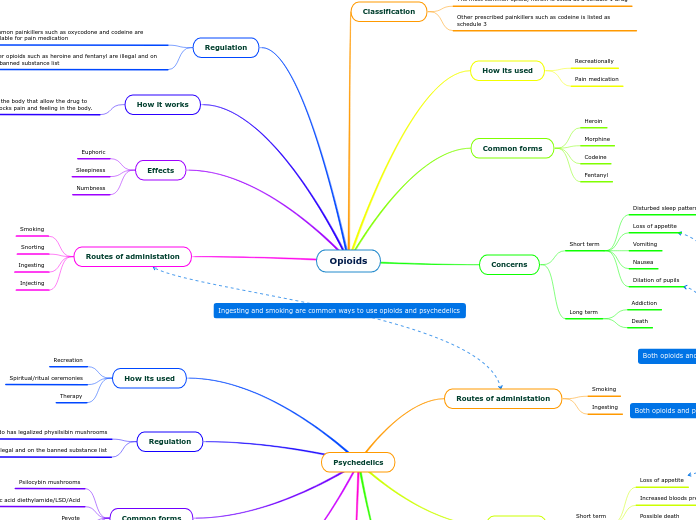Opioids
Classification
The most common opioid, heroin is listed as a schdule 1 drug
Other prescribed painkillers such as codeine is listed as schedule 3
How its used
Recreationally
Pain medication
Common forms
Heroin
Morphine
Codeine
Fentanyl
Concerns
Short term
Disturbed sleep patterns
Loss of appetite
Vomiting
Nausea
Dilation of pupils
Long term
Addiction
Death
Regulation
Common painkillers such as oxycodone and codeine are available for pain medication
Other opioids such as heroine and fentanyl are illegal and on the banned substance list
How it works
There is opioids receptors in the body that allow the drug to bind to the receptors, this blocks pain and feeling in the body.
Effects
Euphoric
Sleepiness
Numbness
Routes of administation
Smoking
Snorting
Ingesting
Injecting
Psychedelics
Routes of administation
Smoking
Ingesting
Concerns
Short term
Loss of appetite
Increased bloods pressue
Possible death
Dilation of pupils
Insomnia
Long term
Loss of self/ego
Effects
Altered state of consciousness
Euphoric
Makes people question reality as we see it
How its used
Recreation
Spiritual/ritual ceremonies
Therapy
Regulation
Recently Colorado has legalized physilsibin mushrooms
Most psychedelics are illegal and on the banned substance list
Common forms
Psilocybin mushrooms
Lysergic acid diethylamide/LSD/Acid
Peyote
Salvia
Dimethyltryptamine (DMT) / Ayahuasca
How it works
Each psychedelic binds to a specific receptor in the brain creating an altered perception of reality for the user.
Classification
Psychedelics all fall under schedule 1 drugs according to the Drug Enforcement Association
